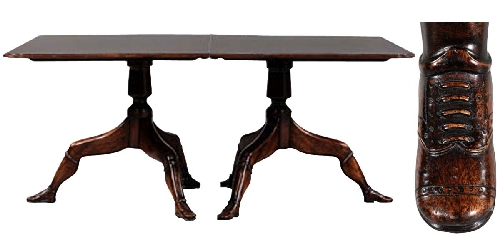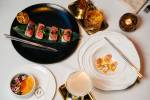Society’s needs improve traditional designs
The last half of the 19th century was a time of creative energy in the United States. Thousands of patents were granted for improvements to household goods, from eggbeaters and apple peelers to vacuum cleaners. Other traditional designs were "improved," like the dining-room table that was originally just a rectangular slab of wood held by a trestle or four legs.
As early as the 1700s, designers had realized that dining tables could be improved by adding extra leaves held by a swing leg at the end of the table or on a slide attached under the tabletop. By the 1800s, slides were made so table leaves could pop into position when the table was pulled apart. Table legs also were a problem. They were bumped by chairs or human legs, so a single large pedestal with low feet was designed, and for extra-long tables, two or more pedestals were used.
Today, dining tables are made following rules not considered in earlier times. Tables are made in standard sizes so tablecloths can be mass-produced to fit any table. A table height of 28 inches also is standard to go with the standard chair's seat height of 18 inches. A higher or lower seat is uncomfortable. And most new tables are 42 to 46 inches wide to match the size that fits in the average dining room. There must be room for the table and the position of the chairs on either side when a family sits down to eat.
When buying vintage or antique tables and chairs, measure your room and the furniture. If heights or widths are wrong, the set will not be comfortable and may even be too large for your room.
Q: My all-white figurine of a rearing horse with its front legs on a column is marked "Kent Art Ware Japan." It is 9 inches tall and looks very modern. When was it made?
A: You have a piece of Kent Art Ware (KAW), which was made in Japan in the 1920s or '30s. Kent designs are very art deco.
David Eaton, a researcher who hosts a website on Kent Art Ware, thinks Kent wares were made at the Moriyama pottery in Japan. Several Japanese-made Western-style figurines have been found that are almost identical except for their marks.
Noritake apparently commissioned Moriyama to make Kent Art Ware, which Noritake then sold in the United States. Several Japanese companies have made special pieces in the American taste and never sold them in Japan.
The name of the brand, Kent, probably was chosen to suggest an American or English company. Most Kent ware is all white. Some pieces are white with added colors on a skirt or leaf. Many resemble pieces made in the deco style by major German and Austrian potteries.
You have a piece of an as-yet-undiscovered collectible, so few people will know what it should cost.
Q: I have a dish marked "1794, Royal Bayreuth, Germany, U.S. Zone." How can I find out how old it is?
A: Royal Bayreuth was founded in Tettau, Bavaria, in 1794. Germany was divided into four occupation zones after the end of World War II. The words "U.S. Zone" indicate your dish was made in the part occupied by U.S. forces from 1945 to 1949.
Royal Bayreuth is still in business but now uses a different mark.
Q: I heard costume jewelry was made by the same people who designed the Barbie doll. I collect anything that goes with Barbie and wondered if what I heard is true.
A: The designers of Barbie, Ruth and Elliot Handler, were two of the founders of Mattel, the company that created and still makes Barbie dolls.
The Handlers started a company named Elzac to make costume jewelry in 1941. The jewelry was inexpensive and was sold by Sears and some department stores. Pins were made of hand-painted ceramics or carved wood. Added trim included Lucite, rhinestones, silver, fur and leather. The pins were large, some 4 inches long. Those that depicted the heads of exotic women were especially popular. The jewelry was marked with a label or hang tag that is probably lost now.
The Handlers sold their share of the company in 1944 and in 1945 started Mattel, which later produced the Barbie doll and other toys.
Q: My grandmother gave me an old carved wooden cane. It's very plain with a curved handle that's carved with the words "Bermuda POW 1915." Can you tell me anything about it?
A: Throughout history, soldiers, sailors and prisoners of war have dealt with boredom by carving whale's teeth or wood to make everything from pipes to furniture. Your cane is an interesting piece of folk art.
When World War I broke out in Europe in 1914, any enemy sailors Britain caught in Bermuda ports became prisoners of war because Bermuda is a British Crown colony. So it's possible your cane was made in Bermuda in 1915 by a prisoner of war. Prisoners taken into custody in Bermuda were later transferred to Canada.
The value of your cane is about $100-$150, depending on the quality of the carving.
Q: My grandparents gave me their large set of Occupied Japan china, including 12 place settings, a soup tureen, sugar and creamer and gravy boat. Each place setting includes a dinner plate, salad plate, bread plate, soup bowl, berry bowl, cup and saucer. The bottoms of most of the pieces are marked "Silver, Made in Occupied Japan." The set is a family heirloom and I wouldn't sell it, but what is it worth?
A: A company named Silver was one of the known manufacturers of dinnerware in postwar Japan. Companies that made dishes or other items for export used the "Made in Occupied Japan" mark from 1947 to 1952.
The value of your 88-piece set depends on its quality and condition. It could be worth anywhere from $200 to $900.
Q: My grandmother had a small glass pitcher with a spout and a hinged metal lid that could be opened by pressing a tab on one side. She called it her "maple syrup pitcher." Can you tell me when this pitcher was made?
A: You have a syrup pitcher. Maple syrup is just one of the types of syrup that could be served in the lidded pitcher. The lid helped keep the syrup from dripping and, most important, kept the flies out. Many companies made glass or silver-plated syrup pitchers in the 19th and early 20th century.
Today we often serve syrup in a pitcher without a lid.
Terry Kovel's column is syndicated by King Features. Write to: Kovels, (Las Vegas Review-Journal), King Features Syndicate, 300 W. 57th St., New York, NY 10019.


























